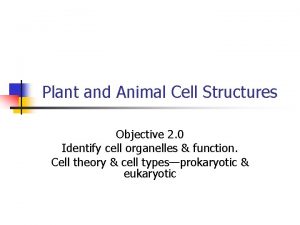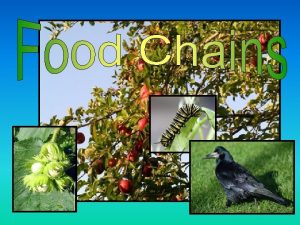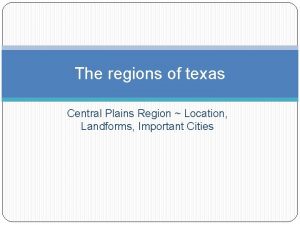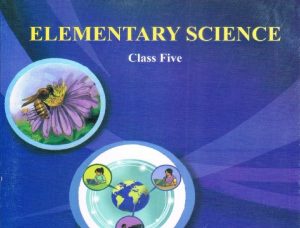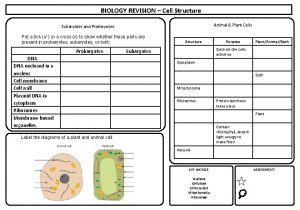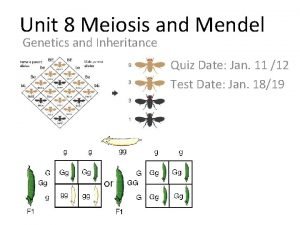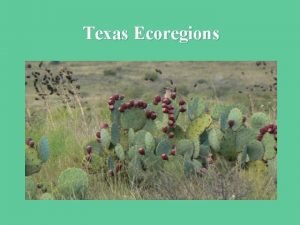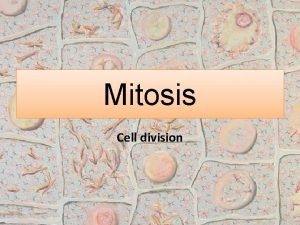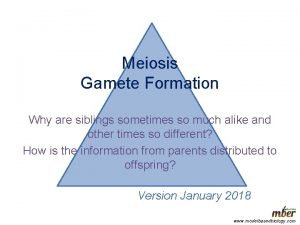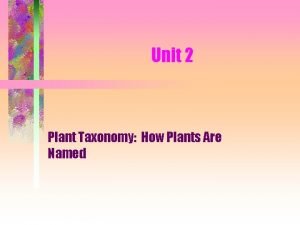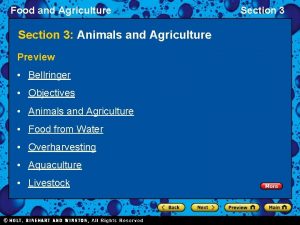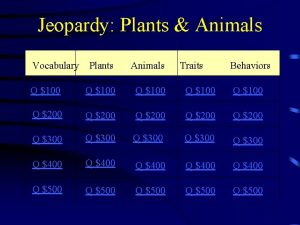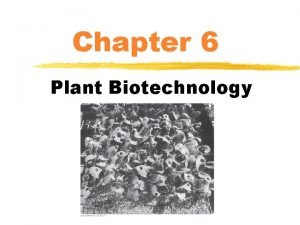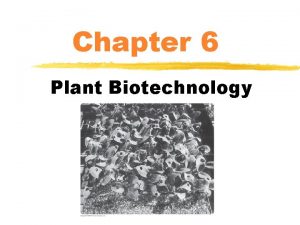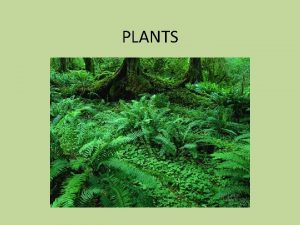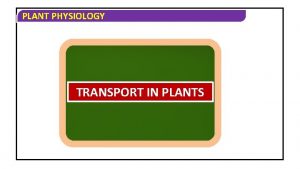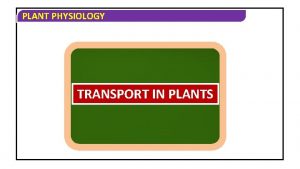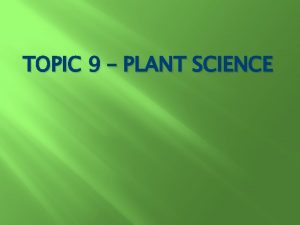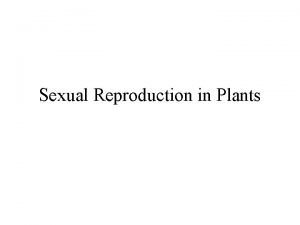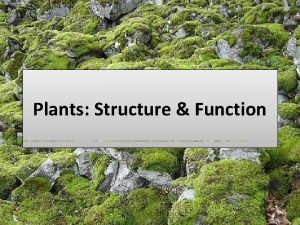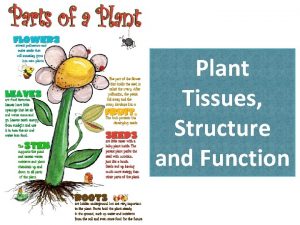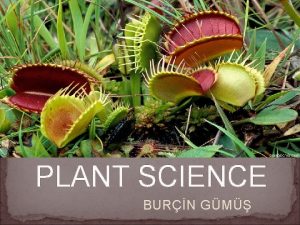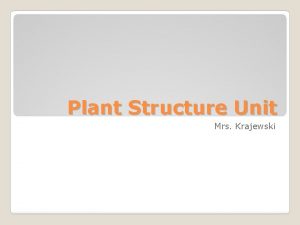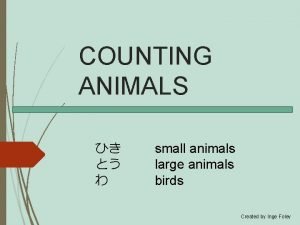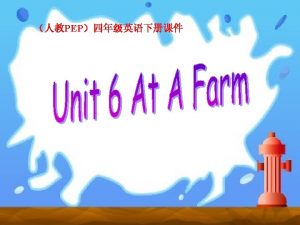Topic Plant Structure Section 1 C Animals Plants





































- Slides: 37

Topic: Plant Structure Section: 1 C Animals, Plants & Micro-organisms 1 C 3 Plant Structure & 1 C 4 Transport in Plants

Diagram 1 Structure and transport in flowering plants Diagram 3 Diagram 2

Outline of Lessons Number of Lessons: Five (1 double for experiments and three single classes) Learning Objectives Lesson 1 • Recognise many types of plants • Differentiate between the regions of a flowering plant • Identify the parts of a flowering plant • Describe the functions of the different parts of the plant • Explain the importance of the leaf as the site of photosynthesis

Outline of Lessons Lesson 2 • Distinguish the various parts of a leaf • Locate where stoma are on a leaf • Be able to state the plural of stoma • Relate the function of the stomata to the two processes of photosynthesis and transpiration • List the types of tissue in a plant • Identify the function of the tissue types in the plant • Describe what is transported in plants • Copy a diagram to illustrate the route of movement of water and food in a plant

Outline of Lessons Lesson 3 • Define transpiration stream • Explain the factors affecting transpiration • Describe experiments to 1. Show the path of water through a plant 2. Show that water is taken in by the roots and passes up and out of a plant 3. Show that water evaporates from the surface of a leaf by transpiration

Outline of Lessons Lesson 4 & 5 • Perform the following experiments 1. Show the path of water through a plant 2. Show that water is taken in by the roots and passes up and out of a plant 3. Show that water evaporates from the surface of a leaf by transpiration

Objective OB 45 identify the main parts of a typical flowering plant and their functions; the root, the stem, leaf & flower

Introduction • Many plant types • Examples: – Algae Diagram 4 – Mosses & ferns – Conifers – Flowering plants Diagram 5 Diagram 6

Main features of flowering plants 1. Divided into roots, stem and leaves 2. Specialised cells for transport of water, minerals and food around plant 3. Reproduce by seeds 4. Seeds enclosed in fruit

Structure of a typical flowering plant Diagram 7: From Exploring Science Teachers Resource CD

Label the parts of a flowering plants Diagram 8: Junior Cert Science A voyage of discovery Teachers CD ROM

The answers Flower Leaf Shoot Stem Roots Diagram 9: Junior Cert Science A voyage of discovery Teachers CD ROM

Functions of the main parts of typical flowering plant 1. Roots – Anchor & support – Absorb water & minerals – Some store food From Clipart

Functions of the main parts of typical flowering plant 2. The stem – Support & holds up leaves & flowers – Transport water, minerals & food – Some stores food

Functions of the main parts of typical flowering plant 3. Leaves – Site of photosynthesis – Allow gas exchange – Allow water vapour to pass out of plant – Some store food

Diagram 10: From Exploring Science Teachers Resource CD.

The Leaf Stoma one pore Stomata two + pores Diagram 11: Junior Cert Science A voyage of discovery Teachers CD ROM

Importance of the leaf Sun Light Chlorophyll Water Carbon dioxide Diagram 12: Junior Cert Science A voyage of discovery Teachers CD ROM

Functions of the main parts of typical flowering plant 4. Buds – Growth point 5. Flowers – Produce seeds for reproduction From Clipart

Objective OB 46 Understand that the xylem transports water and minerals in the plant and that phloem transports food (Higher Level only)

Transport in flowering plants 1. Water 2. Minerals 3. Food Diagram 13

Water Transport • Tiny tubes allow continuous flow of water from roots to leaves • Tiny tubes appear as veins • Stomata allow water evaporation • Transpiration

Water Transport Diagram 14

Plant Tissue • Two types involved in plant transport 1. Xylem – Transport water and dissolved minerals – Made of dead cells & lined with substance to make it water proof and provide support

Plant Tissue 2. Phloem – Transports food from the leaves around the plant Diagram 15 : Exploring Science

Transpiration • Loss of water from a plant • Most occurs through stomata • Functions of transpiration 1. Supplies leaves with water 2. Supplies plant with minerals 3. Helps cool plant down

Transpiration stream This is the upward flow of water through xylem caused by a reduction of pressure at the top of the plant as water is evaporated

Factors Affecting Transpiration 1. Humidity 2. Temperature 3. Wind 4. Soil water content Diagram 16

Objective OB 47 Carry out simple activities to show the path of water through plant tissue, and show that water evaporates from the surface of a leaf by transpiration

To show the path of water through a plant Diagram 19 Diagram 18 Diagram 17 : Exploring Science

To show that water is taken in by the roots and passes up and out of a plant Diagram 20 : Exploring Science

To show that water evaporates from the surface of a leaf by transpiration Diagram 21 : Exploring Science

Bibliography 1. Exploring Science by Michael O’Callaghan, Seamus Reilly & Aiden Seery. Teachers Resource CD revised edition, Edco 2. Exploring Science by Michael O’Callaghan, Seamus Reilly & Aiden Seery. Textbook revised edition, Edco 3. Junior Cert Science : A voyage of discovery. Teachers CD ROM by Hilary Dorgan, Declan Kennedy & Pat Walsh, Folens 4. www. skoool. ie 5. www. ncca. ie for Junior Cert Science curriculum

Resources • Diagram 1 http: //www. midwestaquaticsandexotics. com/ Accessed : 11 th February 2008 • Diagram 2 http: //www. cumbavac. org/Gardening. htm Accessed : 11 th February 2008 • Diagram 3 http: //trc. ucdavis. edu/biosci 10 v/bis 10 v/week 8/08 flowers. html Accessed : 11 th February 2008 • Diagram 4 http: //ridge. icu. ac. jp/gen-ed/lower-plants. html Accessed : 11 th February 2008 • Diagram 5 http: //www. guide 2 christmas. com/i 2 christmas_tree. png Accessed : 11 th February 2008

Resources • Diagram 6 http: //en. wikipedia. org/wiki/Image: Ferocactus 1. jpg Accessed : 11 th February 2008 • Diagrams 7, 10 & 12 Exploring Science by Michael O'Callaghan, Seamus Reilly & Aiden Seery. Teachers Resource CD revised edition, Edco • Diagrams 8, 9 & 11 Junior Cert Science : A voyage of discovery. Teachers CD ROM by Hilary Dorgan, Declan Kennedy & Pat Walsh, Folens • Diagram 13 http: //www. bbc. co. uk/schools/gcsebitesize/img/bixylemphloem. gif Accessed : 11 th February 2008

Resources • Diagrams 15, 17 & 20 Scanned from Exploring Science by Michael O'Callaghan, Seamus Reilly & Aiden Seery. Textbook revised edition, Edco • Diagram 16 http: //www. jardibotanicdesoller. org/eng/guia_cactus. html Accessed : 11 th February 2008 • Diagram 18 http: //discovermagazine. com/2003/mar/featscienceof/? searchterm=my teries Accessed : 11 th February 2008 • Diagram 19 http: //sch. ci. lexington. ma. us/~ccarter/celery Accessed : 11 th February 2008

Resources • Handout & Test Material from Exploring Science by Michael O'Callaghan, Seamus Reilly & Aiden Seery. Workbook revised edition, Edco • Microsoft Power point Clipart
 Consumer decomposer producer
Consumer decomposer producer Animals that eat both plants and animals
Animals that eat both plants and animals Carnivore
Carnivore Https//a-z-animals.com/animals
Https//a-z-animals.com/animals Broad topic and narrow topic examples
Broad topic and narrow topic examples Broad topic and specific topic examples
Broad topic and specific topic examples Genetic vs physical map
Genetic vs physical map Aninal cell
Aninal cell Can plants be keystone species
Can plants be keystone species What cell type
What cell type Venn diagram asexual and sexual reproduction
Venn diagram asexual and sexual reproduction Animals of the temperate deciduous forest
Animals of the temperate deciduous forest Every living plants and animals must have
Every living plants and animals must have Nitrogen in macromolecules
Nitrogen in macromolecules Plants and animals on earth grade 5
Plants and animals on earth grade 5 Animals in the central plains region of texas
Animals in the central plains region of texas Grassland biome animals and plants
Grassland biome animals and plants Texas central plains animals
Texas central plains animals Science class five
Science class five When does respiration take place in animals and plants?
When does respiration take place in animals and plants? Chromosome number
Chromosome number Ecoregions in texas
Ecoregions in texas Differences between mitosis in plants and animals
Differences between mitosis in plants and animals Number of chromosomes in animals and plants
Number of chromosomes in animals and plants Gas exchange in plants and animals venn diagram
Gas exchange in plants and animals venn diagram How does moss reproduce
How does moss reproduce Non vascular plant reproduction
Non vascular plant reproduction Characteristic of non flowering plants
Characteristic of non flowering plants Photosynthesis equation
Photosynthesis equation Non domesticated animals and uncultivated plant life
Non domesticated animals and uncultivated plant life Unit 2 plant taxonomy how plants are named
Unit 2 plant taxonomy how plants are named Introduction in plant breeding
Introduction in plant breeding Plant introduction in plant breeding
Plant introduction in plant breeding Plant introduction in plant breeding
Plant introduction in plant breeding Tronsmo plant pathology and plant diseases download
Tronsmo plant pathology and plant diseases download Tronsmo plant pathology and plant diseases download
Tronsmo plant pathology and plant diseases download Albugo eye
Albugo eye Section 3 animals and agriculture
Section 3 animals and agriculture







